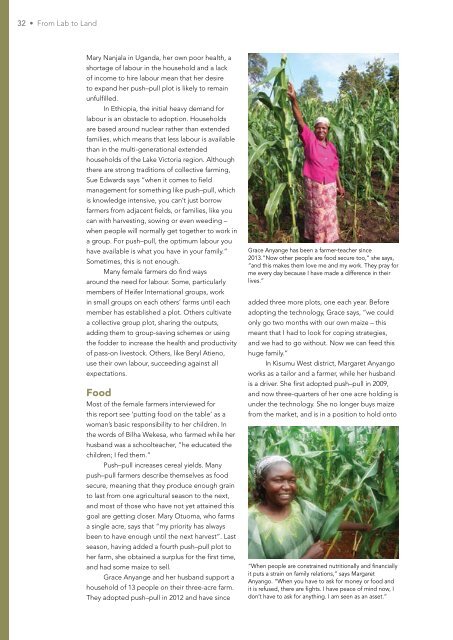to Land
women_in_push-pull
women_in_push-pull
You also want an ePaper? Increase the reach of your titles
YUMPU automatically turns print PDFs into web optimized ePapers that Google loves.
32 • From Lab <strong>to</strong> <strong>Land</strong><br />
Mary Nanjala in Uganda, her own poor health, a<br />
shortage of labour in the household and a lack<br />
of income <strong>to</strong> hire labour mean that her desire<br />
<strong>to</strong> expand her push–pull plot is likely <strong>to</strong> remain<br />
unfulfilled.<br />
In Ethiopia, the initial heavy demand for<br />
labour is an obstacle <strong>to</strong> adoption. Households<br />
are based around nuclear rather than extended<br />
families, which means that less labour is available<br />
than in the multi-generational extended<br />
households of the Lake Vic<strong>to</strong>ria region. Although<br />
there are strong traditions of collective farming,<br />
Sue Edwards says “when it comes <strong>to</strong> field<br />
management for something like push–pull, which<br />
is knowledge intensive, you can’t just borrow<br />
farmers from adjacent fields, or families, like you<br />
can with harvesting, sowing or even weeding –<br />
when people will normally get <strong>to</strong>gether <strong>to</strong> work in<br />
a group. For push–pull, the optimum labour you<br />
have available is what you have in your family.”<br />
Sometimes, this is not enough.<br />
Many female farmers do find ways<br />
around the need for labour. Some, particularly<br />
members of Heifer International groups, work<br />
in small groups on each others’ farms until each<br />
member has established a plot. Others cultivate<br />
a collective group plot, sharing the outputs,<br />
adding them <strong>to</strong> group-saving schemes or using<br />
the fodder <strong>to</strong> increase the health and productivity<br />
of pass-on lives<strong>to</strong>ck. Others, like Beryl Atieno,<br />
use their own labour, succeeding against all<br />
expectations.<br />
Food<br />
Most of the female farmers interviewed for<br />
this report see ‘putting food on the table’ as a<br />
woman’s basic responsibility <strong>to</strong> her children. In<br />
the words of Bilha Wekesa, who farmed while her<br />
husband was a schoolteacher, “he educated the<br />
children; I fed them.”<br />
Push–pull increases cereal yields. Many<br />
push–pull farmers describe themselves as food<br />
secure, meaning that they produce enough grain<br />
<strong>to</strong> last from one agricultural season <strong>to</strong> the next,<br />
and most of those who have not yet attained this<br />
goal are getting closer. Mary Otuoma, who farms<br />
a single acre, says that “my priority has always<br />
been <strong>to</strong> have enough until the next harvest”. Last<br />
season, having added a fourth push–pull plot <strong>to</strong><br />
her farm, she obtained a surplus for the first time,<br />
and had some maize <strong>to</strong> sell.<br />
Grace Anyange and her husband support a<br />
household of 13 people on their three-acre farm.<br />
They adopted push–pull in 2012 and have since<br />
Grace Anyange has been a farmer-teacher since<br />
2013.”Now other people are food secure <strong>to</strong>o,” she says,<br />
“and this makes them love me and my work. They pray for<br />
me every day because I have made a difference in their<br />
lives.”<br />
added three more plots, one each year. Before<br />
adopting the technology, Grace says, “we could<br />
only go two months with our own maize – this<br />
meant that I had <strong>to</strong> look for coping strategies,<br />
and we had <strong>to</strong> go without. Now we can feed this<br />
huge family.”<br />
In Kisumu West district, Margaret Anyango<br />
works as a tailor and a farmer, while her husband<br />
is a driver. She first adopted push–pull in 2009,<br />
and now three-quarters of her one acre holding is<br />
under the technology. She no longer buys maize<br />
from the market, and is in a position <strong>to</strong> hold on<strong>to</strong><br />
“When people are constrained nutritionally and financially<br />
it puts a strain on family relations,” says Margaret<br />
Anyango. “When you have <strong>to</strong> ask for money or food and<br />
it is refused, there are fights. I have peace of mind now, I<br />
don’t have <strong>to</strong> ask for anything. I am seen as an asset.”


